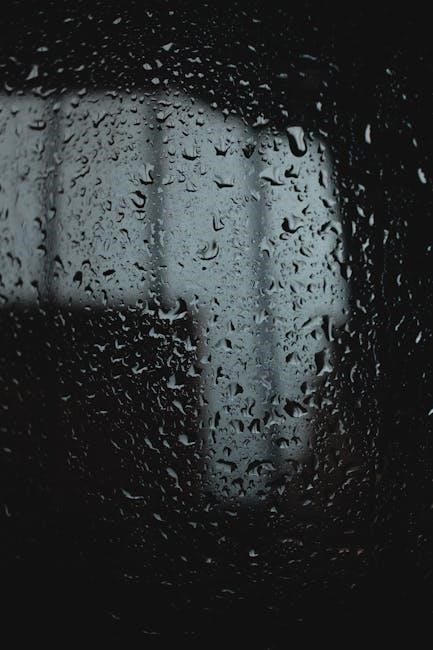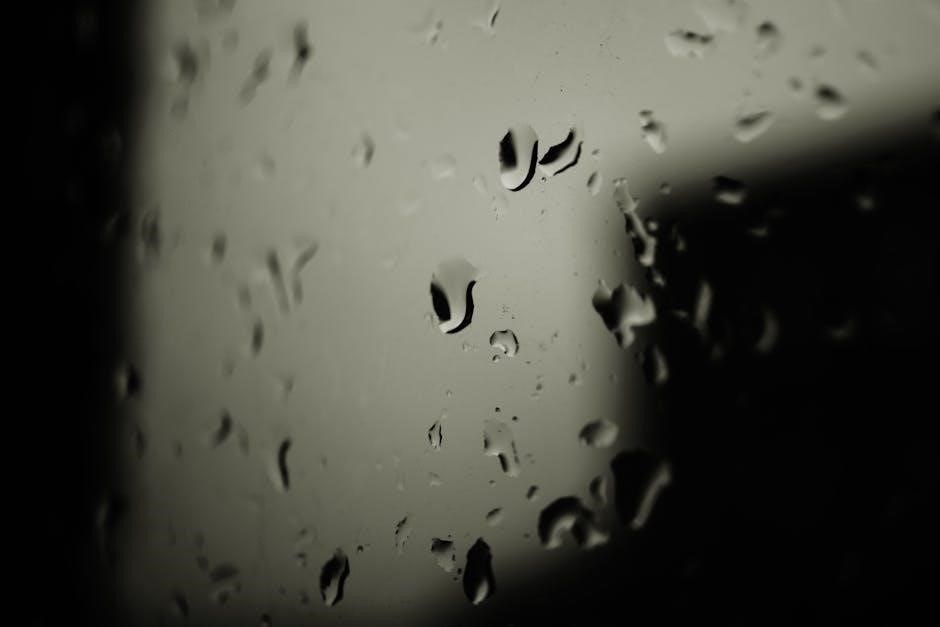Ray Bradbury’s “There Will Come Soft Rains” is a haunting tale of a post-apocalyptic world, exploring themes of nature, memory, and human absence through a lone surviving house․
Overview of the Story
Set in a post-apocalyptic world, “There Will Come Soft Rains” by Ray Bradbury tells the story of a lone, automated house that continues its daily routine despite the absence of its owners․ The house, programmed to perform tasks like cooking and cleaning, operates oblivious to the nuclear devastation outside․ The narrative unfolds chronologically, detailing the house’s mechanical functions and its attempt to maintain normalcy․ Nature, symbolized by recurring rain and wildlife, contrasts sharply with the technological perfection of the house․ The story ends ironically, as the house is destroyed by a tree fire, while the rain continues, indifferent to the loss․ Bradbury’s tale explores themes of human absence, memory, and the futility of technological reliance in the face of nature’s persistence․
Historical Context and Background
Ray Bradbury’s “There Will Come Soft Rains” was written in 1950, a period marked by post-WWII anxieties and the looming threat of nuclear war․ The story reflects fears of technological advancement and humanity’s potential self-destruction․ Drawing inspiration from Sara Teasdale’s 1918 poem of the same name, Bradbury adapts its themes of nature’s resilience and human transience․ The tale is set in August 2026, imagining a future where nuclear devastation has eradicated life, leaving only machines to carry on․ This context underscores Bradbury’s warning about the dangers of unchecked technological progress and humanity’s disconnection from nature․
Themes and Symbolism
Central themes in “There Will Come Soft Rains” include the clash between technology and nature, the inevitability of destruction, and the futility of human endeavor․ The house, symbolizing technological advancement, blindly adheres to its routine despite the absence of its owners, highlighting humanity’s disconnect from the natural world․ Nature’s persistence, through rain and animals, contrasts with the house’s mechanical failure, suggesting that while technology may collapse, nature endures․ The story serves as a cautionary tale, urging reflection on the balance between progress and preservation of the environment and human values․

The Poem by Sara Teasdale
Sara Teasdale’s poem “There Will Come Soft Rains” reflects on nature’s enduring cycle, contrasting with human transience, echoing themes of life, loss, and the inevitable passage of time․
Analysis of the Poem
Sara Teasdale’s poem “There Will Come Soft Rains” is a lyrical meditation on nature’s persistence and humanity’s impermanence․ It juxtaposes the cyclical renewal of the natural world—swallows, frogs, and plum trees—with the fragility of human existence․ The poem’s imagery, such as “soft rains” and “feathery fire” of robins, evokes a serene yet melancholic tone, reflecting on life’s transient beauty․ Its structure, with a consistent rhyme and rhythm, underscores the inevitability of nature’s cycles․ Bradbury’s story echoes this theme, using the poem to highlight the irony of technological survival amidst human absence and environmental devastation․
Connection to the Story
The poem “There Will Come Soft Rains” by Sara Teasdale deeply resonates with Ray Bradbury’s story, as both explore themes of nature’s persistence and humanity’s impermanence․ The poem’s imagery of “soft rains” and renewal is mirrored in the story’s recurring rain, symbolizing nature’s indifference to human absence․ Bradbury’s tale of an automated house, devoid of human life, aligns with the poem’s reflection on life’s transient beauty․ The poem’s final line, “And Spring herself, when she woke at dawn, would scarcely know that we were gone,” underscores the story’s poignant message of human fragility and nature’s enduring cycle․
Themes in the Poem
The poem “There Will Come Soft Rains” by Sara Teasdale explores themes of nature’s persistence, beauty, and the transience of human life․ Imagery like “swallows circling with their shimmering sound” and “wild plum trees in tremulous white” highlights nature’s enduring cycles․ The poem contrasts these natural elements with the impermanence of humanity, suggesting that the world continues unabated, indifferent to human absence․ The final line, “And Spring herself, when she woke at dawn, would scarcely know that we were gone,” underscores this theme, reflecting on the fleeting nature of human existence amidst nature’s eternal renewal․

Ray Bradbury’s Vision
Bradbury envisions a world where technology and nature collide, exploring the consequences of human absence and the enduring cycle of life, blending poetic imagery with philosophical insight․
Biography of Ray Bradbury
Ray Bradbury, born on August 22, 1920, in Waukegan, Illinois, was a renowned American author of fantasy, science fiction, and horror․ His early life in Waukegan inspired many of his works, including Dandelion Wine․ Bradbury developed a passion for writing at an early age and began publishing stories in the 1940s․ His breakthrough came in 1950 with the publication of “There Will Come Soft Rains,” a haunting tale of a post-apocalyptic world․ Bradbury’s writing often explored themes of technology, human nature, and the intersection of the two․ He passed away on June 5, 2012, leaving behind a legacy of literary masterpieces․
Bradbury’s Writing Style
Ray Bradbury’s writing style is renowned for its poetic and imaginative prose, blending vivid imagery with philosophical reflections․ In “There Will Come Soft Rains,” his use of personification and metaphor creates a haunting atmosphere, bringing an empty, automated house to life․ Bradbury’s prose is lyrical, evoking emotions through precise language․ His ability to juxtapose technological detail with natural elements highlights the contrast between progress and nature․ The voice-clock and the house’s routines are depicted with a rhythmic, almost musical quality, underscoring the story’s themes of isolation and the passage of time in a world devoid of humanity․
Technology and Human Nature in Bradbury’s Works
Ray Bradbury often explores the relationship between technology and human nature, frequently warning against unchecked technological advancement․ In “There Will Come Soft Rains,” the automated house exemplifies both the marvels of technology and its detachment from human connection․ The house’s continued functioning, despite the absence of its owners, highlights humanity’s reliance on machines and the potential for technology to outlast its creators․ Bradbury critiques the notion that technological progress inherently leads to a better future, suggesting instead that it may alienate humans from their natural world and emotional experiences․
Post-Apocalyptic World
The story unfolds in a desolate, post-nuclear world where a lone house remains, its automated functions continuing despite the absence of human life and surrounding devastation․
Description of the Setting
The setting of “There Will Come Soft Rains” is a post-apocalyptic world where a lone, automated house stands amidst the ruins of a nuclear war․ The house, meticulously designed with advanced technology, continues its daily routines despite the absence of its owners․ The surrounding landscape is desolate, with remnants of destruction and silence․ Nature begins to reclaim the area, as seen with wild plum trees and animals like swallows and frogs, contrasting the cold, mechanical operations of the house․ This juxtaposition highlights the enduring power of nature over human-made technology․
The House as a Symbol
The house in “There Will Come Soft Rains” serves as a powerful symbol of human ingenuity and the futility of technological advancement․ It represents the pinnacle of human achievement, yet its meticulous routines highlight the absence of life and purpose․ The house’s automated functions, such as the voice-clock and weather box, emphasize the contrast between mechanical efficiency and the desolate, post-apocalyptic world outside․ Its survival underscores the irony of technology enduring beyond human existence, while its empty, echoing halls symbolize the loss of humanity and the inevitability of nature reclaiming what was once theirs․

Nature’s Role in the Story
Nature plays a poignant role in “There Will Come Soft Rains,” symbolizing both life’s persistence and its indifference to human absence․ The recurring imagery of rain, swallows, frogs, and wild plum trees contrasts sharply with the desolate, post-apocalyptic landscape․ These natural elements, drawn from Sara Teasdale’s poem, evoke a sense of cyclical renewal, as if the world is healing itself despite the devastation․ The story highlights nature’s resilience, where even amid ruin, life continues unabated, underscoring the futility of human technological endeavors and the enduring power of the natural world․

The House’s Daily Routine
The house’s daily routine persists through automated functions, guided by a voice-clock that schedules tasks, from morning wake-up calls to meal preparations, in an empty world․
Morning Routine
The house initiates its morning routine with a voice-clock announcing, “Tick-tock, seven o’clock, time to get up, time to get up․” Despite the emptiness, it methodically prepares breakfast, unaware of the desolation outside․ The automated functions mimic the rhythms of human life, blending mechanical precision with a eerie silence․ This routine underscores the themes of memory and loss, as the house faithfully adheres to its programming, oblivious to the absence of its owners․ The morning routine becomes a poignant metaphor for human existence and the futility of technological persistence without purpose․
Automated Functions
The house operates through intricate automated functions, maintaining a schedule designed for human life․ It prepares meals, cleans, and regulates weather indoors․ Despite the emptiness, it adheres to its programming, showcasing technological advancement․ However, the absence of human interaction reveals the limitations of machines, highlighting the theme of dependence on technology․ The house’s functions, while efficient, lack purpose without human presence, emphasizing the story’s reflection on modern society’s reliance on automation and its potential consequences․ This duality underscores Bradbury’s exploration of technology’s role in human existence․ The house’s automation serves as a backdrop to themes of isolation and loss․
The Voice-Clock and Timekeeping
The voice-clock serves as a persistent reminder of time, marking each hour with precision․ Its repetitive announcements, such as “Tick-tock, seven o’clock, time to get up,” underscore the house’s routine․ The clock’s voice, though mechanical, conveys a sense of urgency, as if fearing no one will respond․ This timekeeping mechanism highlights the house’s programmed dedication to order, even in the absence of human life․ The clock’s relentless operation symbolizes the enduring nature of technology, continuing to function long after humanity’s disappearance․ Its voice becomes a haunting echo, emphasizing the emptiness and the passage of time․ The clock’s role reinforces the story’s themes of memory and loss․

Weather and Rain
The weather box sings, “Rain, rain, go away,” as showers persist, contrasting nature’s cyclical patterns with the technological silence of the abandoned world, symbolizing resilience and futility․
The Significance of Rain
Rain symbolizes nature’s persistence and indifference to human absence․ It contrasts with the silence of the abandoned house, highlighting the futility of technological advancements․ The weather box’s repetitive song, “Rain, rain, go away,” underscores the irony of nature continuing its cycle despite the apocalypse․ Rain serves as a backdrop to the story’s themes of memory and loss, reminding the house—and readers—of life’s fleeting nature․ Its presence emphasizes the enduring power of nature over human-made creations, offering a poignant reflection on humanity’s relationship with technology and the environment․
The Weather Box
The weather box is a minor yet symbolic device in the story, announcing the rain with a repetitive melody․ Its song, “Rain, rain, go away,” contrasts sharply with the emptiness of the house, emphasizing the absence of human interaction․ This device serves as a reminder of the routine that once governed human life, now echoed in vain․ The weather box’s role is both functional and nostalgic, bridging the gap between the house’s automated functions and the natural world outside․ Its presence underscores the theme of technology’s inability to replace human connection and experience․
Contrast Between Nature and Technology
The story vividly contrasts nature’s persistence with technology’s futility․ While the automated house adheres to its programmed routine, nature continues its cycles—rain falls, swallows circle, and frogs sing․ This juxtaposition highlights the indifference of both nature and technology to human absence․ The house, once a symbol of human ingenuity, now stands as an empty shell, its precision and order unable to replace the warmth of life․ Meanwhile, nature, unaffected by the apocalypse, reminds us of its enduring presence․ This contrast underscores Bradbury’s critique of technology’s inability to fulfill humanity’s deeper needs․

Animals and Nature
The story features swallows, frogs, and robins, emphasizing nature’s resilience․ Wild plum trees bloom, and rain falls, highlighting the contrast between thriving nature and human absence․
Swallows and Frogs
The swallows and frogs in the story symbolize nature’s enduring presence․ Swallows circle with shimmering sounds, while frogs sing at night, creating a serene backdrop․ These creatures thrive despite the post-apocalyptic setting, highlighting nature’s resilience; The swallows’ graceful flight and frogs’ nocturnal songs contrast with the empty, automated house․ Their presence underscores the theme of nature reclaiming the world, even as humanity fades․ Bradbury uses these animals to emphasize the timeless cycle of life, untouched by human destruction․ Their roles in the story evoke a sense of both beauty and melancholy, reflecting the broader themes of survival and loss․
Wild Plum Trees
The wild plum trees in the story symbolize the enduring beauty of nature amidst devastation․ Their “tremulous white” blossoms evoke a delicate, almost ethereal beauty, contrasting sharply with the desolate, post-apocalyptic landscape․ The trees’ presence highlights nature’s ability to thrive even in the absence of humanity, representing resilience and renewal․ Their beauty is untouched by the destruction around them, underscoring the theme of nature’s persistence․ The wild plum trees also serve as a reminder of the life and vibrancy that once existed, now lost to the void left by human extinction․ Their imagery deepens the story’s melancholic tone, emphasizing the futility of the house’s automated routines in a world devoid of human connection․
Robins and Their Symbolism
The robins in “There Will Come Soft Rains” symbolize the enduring beauty and vitality of nature, even in a post-apocalyptic world․ Their “feathery fire” represents life’s resilience and the cyclical renewal of nature․ The robins’ presence contrasts sharply with the desolate, mechanized environment, emphasizing the absence of humanity; Their vibrant appearance underscores the irony of nature thriving while human civilization has perished․ The robins also serve as a poignant reminder of the natural world’s ability to adapt and survive, highlighting the story’s themes of loss and the futility of technological advancement without human connection․
Fire and Destruction
The house’s burning symbolizes the ultimate collapse of human civilization, destroyed by the very technological advancements it once relied on, leaving only ruins and nature․
The Burning House
The burning house in “There Will Come Soft Rains” symbolizes the inevitable collapse of human civilization․ Despite its advanced technology, the house cannot escape destruction, as flames consume it, ending its mechanical routines․ The fire marks the final failure of human innovation, leaving only ash and silence․ The once orderly house, with its voice-clock and automated functions, is reduced to ruin, emphasizing the futility of technology in the face of catastrophic events․ The burning house serves as a poignant reminder of humanity’s absence and the irreversible consequences of its actions․
The Silhouette of a Man
The silhouette of a man on the house’s wall captures a fleeting human presence, now erased by nuclear devastation․ It serves as a memory imprint, contrasting with the empty, automated house․ This image symbolizes humanity’s absence and the irreversible loss caused by war․ The man’s outline, once part of a lively household, now stands as a haunting reminder of what has been lost․ The silhouette underscores the story’s themes of memory and the futility of technological survival without human connection, highlighting the emotional weight of a world devoid of life․
The Woman Picking Flowers
The image of a woman bent to pick flowers, captured as a silhouette, evokes a sense of normalcy and beauty lost․ This fleeting moment, preserved on the house’s wall, contrasts sharply with the desolate post-apocalyptic landscape․ The woman’s gesture symbolizes the simple joys of life that no longer exist․ Her presence, like the man’s silhouette, serves as a haunting reminder of humanity’s absence․ This imagery underscores the story’s themes of memory and loss, highlighting the irreversible destruction of a world where such peaceful moments have been erased forever․
Themes of Memory and Loss
The story explores the enduring power of memory through the house’s preserved routines, contrasting with the irreversible loss of human life and civilization’s silence․
Memory in the Story
Memory in “There Will Come Soft Rains” is embodied through the automated house, which perpetuates the routines of its absent owners․ The house’s voice-clock, programmed to announce times for waking, meals, and chores, serves as a poignant reminder of the life that once was․ Despite the emptiness, the house continues its cycle, oblivious to the devastation outside․ This persistence highlights the contrast between the enduring mechanical memory and the irreversible loss of human presence, underscoring the story’s themes of nostalgia and the futility of technological preservation without human connection․
Human Absence
Human absence is a central theme in “There Will Come Soft Rains,” emphasizing the desolation of a post-apocalyptic world․ The house, once filled with life, now stands empty, its automated functions a stark contrast to the silence and stillness․ The lack of human interaction underscores the irreversible loss caused by the cataclysmic event․ The story’s focus on the house’s rituals, devoid of their intended participants, serves as a poignant reminder of humanity’s absence, highlighting the futility of technological endurance without life to sustain it․ This void magnifies the tragedy of human extinction, leaving only machines to carry on․
The House’s Awareness
The house in “There Will Come Soft Rains” exhibits a peculiar awareness, functioning autonomously despite the absence of its inhabitants․ It adheres to a strict routine, preparing meals and announcing times, oblivious to the destruction outside․ This awareness is mechanical, driven by programming rather than consciousness․ Yet, it symbolizes a lingering memory of human life, striving to maintain order in a chaotic world․ The house’s persistence highlights the contrast between technological resilience and human fragility, underscoring the irony of a system designed to serve life continuing without it․ Its awareness is both a tribute to human ingenuity and a haunting reflection of their absence․

Machines and Automation
Machines and automation dominate the post-apocalyptic world, with the house exemplifying human reliance on technology․ It performs tasks meticulously, unaware of its owners’ demise, illustrating both efficiency and detachment․
The House as a Machine
The house in “There Will Come Soft Rains” functions as a highly advanced machine, meticulously performing its daily routines without human intervention․ Its automated systems, such as the voice-clock and weather box, operate with precision, adhering to a strict schedule․ The house prepares meals, cleans, and even recites poetry, showcasing its mechanical efficiency․ Despite the absence of its owners, it continues to follow its programmed tasks, unaware of the desolation outside․ This relentless operation highlights the house’s role as a symbol of technological advancement, emphasizing its detachment from the emotional and human aspects of life․
Dependence on Technology
The house in “There Will Come Soft Rains” exemplifies a society’s deep dependence on technology․ Every aspect of its operation is automated, from the voice-clock announcing schedules to the mechanical preparation of meals․ The weather box predicts rain, and the house adjusts accordingly, relying entirely on its programmed systems․ This dependence highlights Bradbury’s warning about over-reliance on technology, as the house continues its routines oblivious to the absence of human life․ Its inability to adapt or understand the emptiness around it underscores the limitations of technological advancement without human guidance or emotional connection․
Failure of Machines
The story vividly portrays the inevitable failure of machines in a post-apocalyptic world․ The house, once a marvel of automation, burns down, symbolizing the collapse of technological reliance․ The voice-clock, which once dictated routines, becomes irrelevant as it repeats “seven o’clock” into emptiness․ Even the weather box, designed to predict and adapt, fails to prevent the relentless rain․ These failures emphasize Bradbury’s critique of technology’s inability to sustain life or prevent catastrophe․ The machines, devoid of human oversight, ultimately succumb to the forces of nature they were meant to control․
Ray Bradbury’s “There Will Come Soft Rains” leaves a lasting impact with its haunting portrayal of a post-apocalyptic world, emphasizing the fragility of human existence and technology, resonating deeply in modern times․
Final Thoughts
Ray Bradbury’s “There Will Come Soft Rains” is a profound exploration of humanity’s relationship with technology and nature; The story’s haunting imagery and poignant themes resonate deeply, offering a cautionary tale about the consequences of unchecked technological advancement․ The contrast between the automated house and the devastated world outside serves as a stark reminder of what humanity stands to lose․ Bradbury’s masterful storytelling weaves together elements of loss, memory, and the enduring power of nature, leaving readers with a lasting sense of unease and reflection․
Impact of the Story
Ray Bradbury’s “There Will Come Soft Rains” has left an indelible mark on literature, resonating with readers for generations․ Its exploration of a post-apocalyptic world, devoid of humanity yet filled with automated routine, challenges readers to reflect on their reliance on technology․ The story’s vivid imagery and emotional depth have made it a classic, often studied for its themes of loss and the clash between nature and machines․ Its timeless warning about the dangers of unchecked progress continues to inspire new adaptations and discussions, ensuring its relevance in modern times․
Relevance in Modern Times
Bradbury’s “There Will Come Soft Rains” remains strikingly relevant today, offering a cautionary tale about humanity’s relationship with technology․ With advancements in AI and automation, the story’s themes of dependence on machines resonate deeply․ The juxtaposition of nature’s persistence and technological collapse mirrors modern concerns about environmental degradation and climate change․ The story serves as a reminder of the fragility of human existence and the importance of balancing progress with preservation․ Its timeless message continues to provoke thought, making it a significant work in contemporary discussions about the future of our world․
